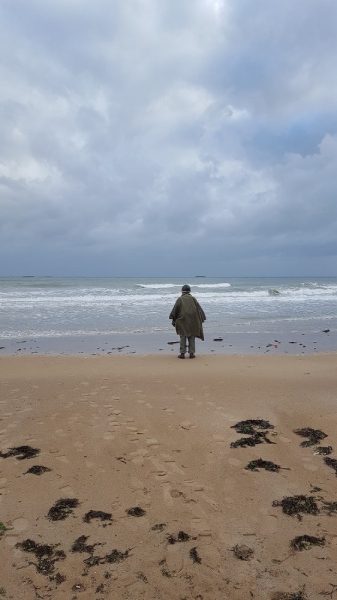6th June 2017 - D-Day + 73 years

This was one of the most emotional trips I’ve ever taken.
Although I have been to the area many times, this was the first time I was actually there on 6th June, the anniversary of D-Day. The roads, lanes and beaches were crowded with people dressed in WW2 uniforms and costumes, many of them driving vintage jeeps. The outfits were very authentic, even the hair styles - but it did seem a bit odd. Apparently lots of nationalities do re-enactments although it seems to be most popular with the Dutch.
On the evening of 5th June we stayed at the Hotel de la Marine in Arromanches just a few steps from one of the D-Day beaches.
All through the night a storm had raged, just as it did on 5th June 1944. When I woke the next morning it had abated slightly and I decided to brave the weather and walk to the beach. I doubted I would ever be this close to Gold Beach on 6th June again. I wanted to stand on the sands at 7.25am. That’s the exact time, and place, British troops came ashore in 1944. It seemed to be the least I could do.
I expected lots of people to be there but only a few people were around. We nodded to each other but didn’t speak; standing quietly seemed to be the right thing to do. Just like in 1944, the storm was mostly over - although the wind was still howling, the sea was still pounding ashore and the sky was grey.
In the middle of the beach a man stood alone. He was dressed in a war-time army uniform and seemed ghostly – like a soldier who had never gone home.
That afternoon we went to Bayeux Cathedral for a Remembrance ceremony organised by the British Legion. The finale was a performance of “I vow to thee my country.” With a band playing and the choir singing it was very moving - but then three bagpipes at the rear of the Cathedral joined in too. It was a beautiful sound, a stereo of emotion - I don’t think there was a dry eye in the Cathedral.
It was raining as we left. I heard someone complain about how the weather had worsened. A veteran, frail in his wheelchair, looked up and said simply;
“It rained on D-Day too.”
From the Cathedral we walked to the other side of Bayeux to the British War Cemetery for a ceremony. We took our seats, the wind blew and sunshine and showers competed for dominance.
At the end of the service surviving Vets, one after another laid their poppy wreaths. Those in wheelchairs, so unsteady on their feet now, stood and walked determinedly across the greenest grass to place their tributes. Then they stood as straight as they were able, their battle medals speaking of conflicts faced, and saluted their lost comrades. I felt very humble.
We walked back into town for lunch, passing an infant school where children in the play ground were watching the crowds disperse. Laughing and waving they started singing La Marseillaise as we passed by. We smiled and waved back, the sombre mood broken but the pride remaining.
The next day in Caen we visited the Caen Memorial Museum. It starts at the beginning and follows the five foul years of war to the end – and it doesn’t hold back. The huge photographs of brutality, executions and extermination camps prove how necessary the sacrifices of D-Day were.
It was hard to take. Drained, I went into the garden for some fresh air and paused at a memorial to French Resistance fighters.
In front of me stood a small grey haired man in a grey jacket and grey trousers. He turned and looked at me with eyes that were sad. He was French, I only speak a little French so I couldn’t understand everything he said, but I got the main words as he told me about his pere, his father. On D-Day, with the Allies approaching, the Gestapo executed his father, a captured resistance fighter. “I was six years old,” he told me. His last word means the same in English - terrible.
I wanted to say something to comfort him but I didn’t have the words in French.
Nor did I have them in English.